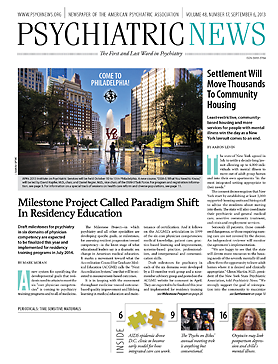Psychotic symptoms are a striking marker of suicide risk in adolescents, especially in those who demonstrate other types of psychiatric pathology as well.
This is the key finding of a study headed by Ian Kelleher, M.D., Ph.D., a research fellow with the Royal College of Surgeons in Ireland and published online July 17 in JAMA Psychiatry.
Kelleher and his colleagues enrolled 1,112 adolescents in Ireland in their study, 91 percent of whom were aged 13 or 14. The subjects were evaluated with the Strengths and Difficulties Questionnaire, a self-report measure that has been validated for its ability to identify different types of psychopathology in children and adolescents. This psychopathology includes anxiety disorders, depressive disorders, conduct disorder, attention-deficit/hyperactivity disorder, and psychotic symptoms (both frank and attenuated).
Of the 1,112 subjects, 77 reported experiencing psychotic symptoms, 146 reported experiencing other types of psychopathology, and 47 reported experiencing both psychotic symptoms and other types of psychopathology.
The subjects were then followed for one year to determine whether any made a suicide attempt. The researchers found that there was a relationship between psychotic symptoms and suicide attempts. Twenty percent of those with psychotic symptoms made a suicide attempt within the following year, whereas only 3 percent of the rest of the cohort did. This meant that the former group was 11 times more likely to attempt suicide than the latter group.
Moreover, 34 percent of those experiencing psychotic symptoms plus other types of psychopathology made a suicide attempt within the follow-up period. In contrast, only 13 percent of those experiencing psychopathology without psychotic symptoms made such an attempt. This means that those who experienced both psychotic symptoms and other types of psychopathology were 33 times more likely to attempt suicide during the following year than the rest of the cohort, whereas those experiencing psychopathology without psychotic symptoms were only five times more likely to attempt suicide during the following year.
Thus, psychotic symptoms in adolescents “are a very valuable clinical marker of risk for suicidal behavior,” Kelleher told Psychiatric News. This finding came as a surprise to him, he said. “While we knew that people with psychotic disorders are at high risk of suicidal behavior, we did not know that there was such a strong relationship between psychotic experiences (which are much more common than psychotic disorders) and suicidal behavior in the population.”
Kelleher and his colleagues will next use brain imaging and genetics to see whether they can determine why psychotic experiences in adolescents are so predictive of suicidal behavior. For instance, could certain brain abnormalities or genetic susceptibilities be the reason? “We will also be looking at risk for suicidal behavior in young people with psychotic experiences when followed up over longer periods,” he said.
“This is a very interesting study,” child and adolescent psychiatrist Kayla Pope, M.D., told Psychiatric News. Pope is also director of neurobehavioral research at Boys Town National Research Hospital in Boys Town, Neb. “We need better markers for assessing suicide risk, and the finding in this study is an important step in that direction. As clinicians we don’t often do a good job of assessing more subtle signs of cognitive impairment or psychotic thoughts in the absence of frank psychosis. It would be interesting to replicate this study with military personnel in whom we are seeing historically high rates of suicide. It may be that displacement and exposure to traumatic events make them more vulnerable to these subtle impairments in thinking.”
The study was funded by the European Union Seventh Framework Program and the Health Research Board Ireland. ■
